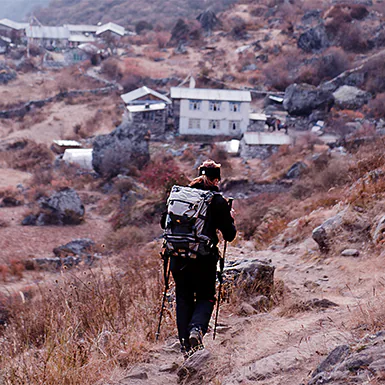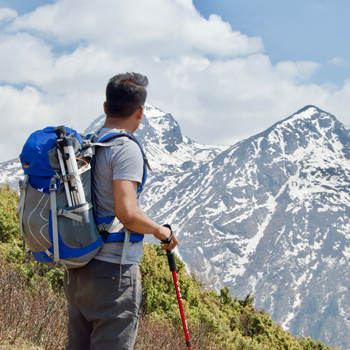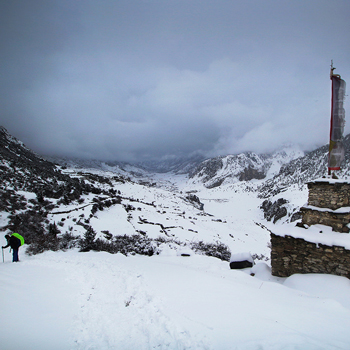Based on 746 reviews
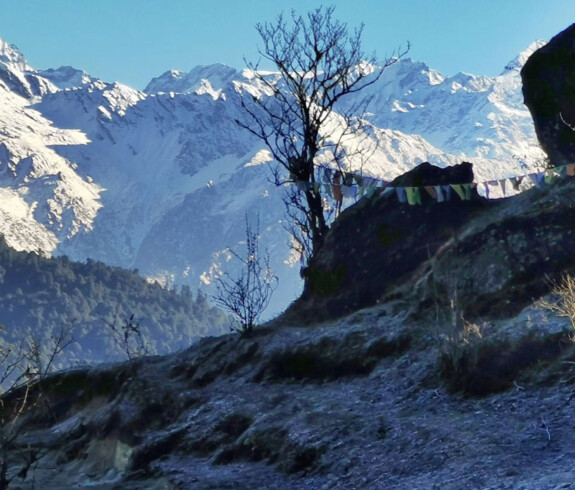
Langtang Helambu Trek
A moderate level trek in the Langtang National Park.
Duration
Meals
- 16 breakfast
- 13 Lunch
- 13 Dinner
Accommodation
- 3-nights hotel
- 13-nights eco-lodge
Activities
- Sightseeing
- Trekking
- Mountain View
SAVE
€ 250Price Starts From
€ 1250
Overview of Langtang Helambu Trek
Langtang Helambu Trek starts with the bus ride to Syaprubeshi, Rasuwa, from Kathmandu. The Langtang trekking would be a mesmerizing experience. Trekker encounters animals, birds, and terrains. However, dangerous animals are rarely encountered. Instead, the sight of a national bird of Nepal, Daphe (Lophophorus), Rhododendron Forests, and Monkey is a bonus. And Wildcats would be an enthralling experience.
The Langtang Gosaikunda, Helambu Trek region, boasts a vibrant feeling of remoteness and peace. Even if it is so near to Kathmandu. The nearest trekking route of Nepal excites you with the diverse package of downhill and uphill trails, witnessing the birds, animals, forests, rivers, and mountains.
Langtang Helambu Trek Highlights
- Sightseeing in UNESCO Heritage sites
- Langtang Valley Explore
- Sacred Lake – Gosainkunda
- Himalayan View from Kyanjin Ri (4350 meters)
- Lauribinayak Pass (4610 meters)
- Helambu Valley
Gosainkunda Lake stands as the landmark high-altitude natural water reservoir. The wilderness and the fear of the unknown prevail. Langtang Helambu Trek on the faint trail would give your adrenaline the test of perseverance and excitement.
The sacred lake for Hindu and Buddhist followers shows you the moral lesson of religious harmony. The lake itself symbolizes the sacrifice for the cause of goodness.
Lord Shiva once drank the poison extracted from the Sea to save humanity. Poison nearly destroyed people. He felt enormous pain and stroked the hills of Gosaikunda. I am eventually forming the source of water for the Lake. The water neutralized the pain and poison. Therefore, the lake is the symbol of eternal peace and sacrifice.
Every year, thousands of domestic and international tourists visit this sacred place. The Langtang trek is highly recommended for the unique experience of religion, harmony, and nature.
Langtang Helambu Trek route information
Helambu is the nearest trekking destination to Kathmandu valley. It lies within the Langtang National Park. The cool breeze amidst the lush green forests highlights the Langtang Helambu trek. Moreover, Tamang origin people mainly live in this area. They allow you to experience the authentic Mongolian locals of the region.
Melamchighyang and Tarkeghyang take you to another level while trekking. Either monasteries or Gumbas and gompas on the way make you as spiritual as ever. The local water mills, chirping birds, hustling and bustling rivers, and peaceful nature make your trek in the Langtang Helambu trek region a spiritual and vibrant trekking experience.
Book with us. Undoubtedly, the Helambu trek is the best-diversified trail in Nepal. Peregrine Treks ensure impeccable hospitality and quality service.
Detail Itinerary of Langtang Helambu Trek
Day 1: Arrival in Kathmandu (1,400m)
Your Himalayan escapade commences as you land at Tribhuvan International Airport, the entryway to Nepal. A Peregrine Treks and Tours representative greets you warmly and guides you to your hotel in Kathmandu.
After settling in, take a moment to relax and acclimate to the higher altitude. You could explore the bustling streets of Thamel, a vibrant district known for its diverse shops, restaurants, and lively atmosphere.
Later in the day, enjoy the delicious flavors of Nepalese cuisine, perhaps savoring a traditional dal bhat or trying momos, a beloved local dumpling.
Relax at your hotel in the evening, or explore Kathmandu’s cultural scene with an artistic performance featuring traditional music and dance.
Accommodation: The Everest Hotel
Meal: Not Included
Day 02: Sightseeing in Kathmandu valley
Experts from Peregrine Treks and Tours will guide you on an intriguing trip through Nepal’s cultural core, exploring the UNESCO World Heritage Sites in Kathmandu Valley.
Your exploration starts at Boudhanath Stupa, Nepal’s largest spherical stupa and a significant pilgrimage destination for Buddhists. Admire the stupa’s intricate architectural details and observe the devoted pilgrims circumambulating it.
The following instructions guide you in immersing yourself in Hindu culture at Pashupatinath Temple, a revered shrine dedicated to Lord Shiva. Besides watching the temple rituals and ceremonies, you may also see the cremation ghats along the Bagmati River.
End your day by visiting Durbar Square, a historic complex of palaces and temples, where you can soak in the atmosphere of ancient Nepal and appreciate the buildings’ intricate craftsmanship.
Accommodation: The Everest Hotel
Meal: Not Included
Day 3: Drive to Syabrubesi (1,460m) | 7-8 hours
After a hearty breakfast, bid farewell to Kathmandu and start your scenic drive to Syabrubesi, the starting point for your trek into the Langtang region.
The trip winds through captivating landscapes, revealing terraced fields, lush forests, and charming villages. As you ascend higher, the air becomes refreshing, and the excitement for the upcoming trek intensifies.
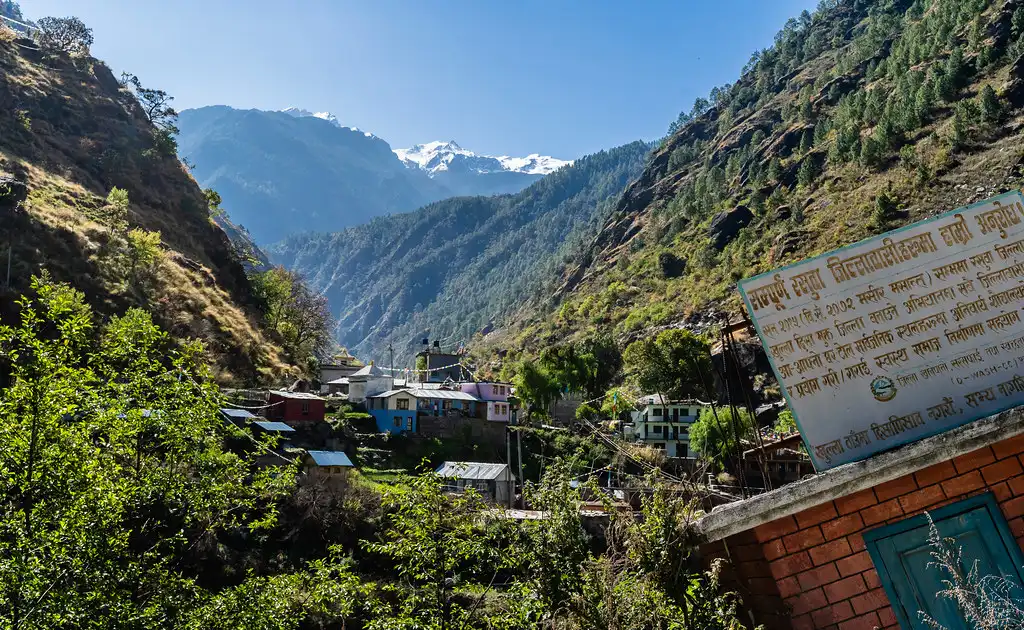
Upon reaching Syabrubesi, you’ll have plenty of time to settle into your accommodations, explore the village, and prepare for the trekking adventure ahead, facilitated by Peregrine Treks and Tours.
Stroll through narrow alleys, where locals greet you warmly, and you can enjoy the peaceful serenity of mountainous settlements.
Accommodation: Local Lodge or Teahouse
Meal: Breakfast, Lunch, and Dinner
Day 4: Trek to Lama Hotel (2,470m) | 5-6 hours
Lace-up your boots and begin your trek. The path gently climbs through vibrant forests, where the sweet scent of rhododendrons fills the air. As you walk alongside the rushing Langtang River, enjoy the calming sounds of nature and the occasional sight of waterfalls cascading down the mountainside.
The terrain shifts as you progress, presenting challenges and rewards. Suspension bridges, swaying gently over the river, add an element of adventure to your trek. The verdant landscape reveals the region’s rich biodiversity. Be looking for vibrant birds and playful langur monkeys inhabiting the forest.
At the end of a fulfilling day of hiking, you’ll arrive at Lama Hotel, a welcoming teahouse nestled amongst the trees. Unwind, enjoy a warm meal, and reflect on the day’s scenic wonders.
Accommodation: Local Lodge or Teahouse
Meal: Breakfast, Lunch, and Dinner
Day 5: Trek to Langtang Village (3,430m) | 5-6 hours
Today, your trek leads you higher into the Langtang Valley, where the scenery becomes even more awe-inspiring.
As you ascend, the forests transition into expansive alpine meadows that bloom with spring wildflowers. Watch for grazing yaks, a quintessential sight in the Himalayas.
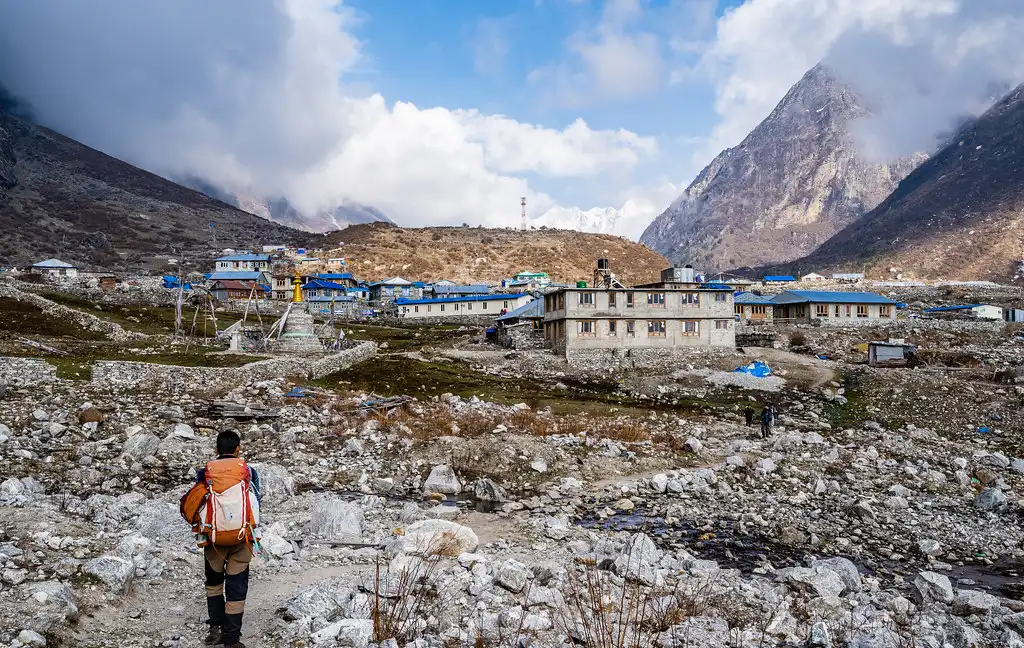
The winding trail offers panoramic views of snow-capped peaks that seem to touch the sky. Though the air is thin, it’s invigorating, and each step brings you closer to the heart of Langtang. As you approach Langtang Village, experience the warmth and hospitality of the Tamang people, who have resided in harmony with the mountains for generations.
Experience the local culture during your evening in Langtang Village. Savor traditional Tamang dishes, explore the local monastery, or relax and relish the mountain atmosphere.
Accommodation: Local Lodge or Teahouse
Meal: Breakfast, Lunch, and Dinner
Day 6: Trek to Kyanjin Gompa (3,870m) | 3-4 hours
The final stretch of this trek section takes you to Kyanjin Gompa, the highest point of the Langtang Valley hike. The path continues through yak pastures, offering breathtaking vistas of the surrounding peaks. Be aware of the thinner air at this altitude, and take your time enjoying the gradual ascent.
Reaching Kyanjin Gompa rewards you with a sense of accomplishment and a deeper appreciation for the Himalayas’ natural beauty. The monastery is a haven of serenity and spirituality, providing a welcome respite after your trip.
Please spend some time exploring the gompa and its surroundings. Hike to a nearby vantage point for even more spectacular panoramas, or unwind and absorb the peaceful ambiance. Use this time to reflect on your trek and prepare for the next part of your adventure.
Accommodation: Local Lodge or Teahouse
Meal: Breakfast, Lunch, and Dinner
Day 7: Acclimatization and Exploration (3,870m)
Spend today adjusting to the high altitude in Kyanjin Gompa. Relax and let your body acclimatize at a leisurely pace. Explore the monastery, wander the charming village, or converse with friendly locals.
If you prefer a more active approach, challenge yourself with a short hike to Kyanjin Ri (4,773m) or Tserko Ri (5,000m). These lookouts reward your effort with unparalleled panoramas of the Langtang Lirung and other snow-capped peaks.
Remember to prioritize hydration, nutrition, and self-awareness during acclimatization. It will ensure your preparedness for the remaining days of the trek.
Accommodation: Local Lodge or Teahouse
Meal: Breakfast, Lunch, and Dinner
Day 8: Trek to Lama Hotel (2,470m) | 5-6 hours
After a rejuvenating day in Kyanjin Gompa, descend to the Lama Hotel. Retrace your steps and rediscover familiar scenery from a fresh perspective. The easier downhill trek is gentler on your lungs and legs, fully allowing you to appreciate the lush forests and cascading waterfalls.
As you traverse the valley, reflect on the incredible trek so far. Memories of snow-capped peaks, vibrant prayer flags, and warm local hospitality will linger long after the trek concludes.
Upon arrival at Lama Hotel, settle back into the cozy teahouse and enjoy a comforting meal and well-deserved rest. Share tales of your experiences with fellow trekkers and prepare for the next phase of your Langtang Helambu adventure.
Accommodation: Local Lodge or Teahouse
Meal: Breakfast, Lunch, and Dinner
Day 9: Trek to Thulo Syabru (2,210m) | 5-6 hours
Bid farewell to Langtang Valley and start a new leg of your trip into the Helambu region. The trail leads you down through dense bamboo forests, offering a refreshing change of scenery. As you descend, the air warms, and the vegetation grows more vibrant.
The path then ascends towards Thulo Syabru, a charming Tamang village renowned for its apple orchards. The ascent gradually rewards you with breathtaking vistas of the surrounding valleys and hills.
Upon reaching Thulo Syabru, dedicate some time to exploring the village and connecting with the welcoming locals. You might even have the opportunity to sample some of the delicious apples that have made the town famous.
Accommodation: Local Lodge or Teahouse
Meal: Breakfast, Lunch, and Dinner
Day 10: Trek to Shin Gompa (3,330m) | 5-6 hours
Begin your day with a scenic hike through captivating forests and charming villages. The trail gradually ascends, leading you through diverse landscapes as you gain altitude. Along the way, the warmth and hospitality of the locals infuse your trekking experience with cultural richness.
As you climb higher, the terrain shifts, unveiling breathtaking vistas of the surrounding mountains. The air grows crisper, and the scenery becomes increasingly majestic. Look for the vibrant rhododendron blossoms and elusive wildlife that inhabit this region.
Reach Shin Gompa, a Buddhist monastery perched atop a hill. The monastery offers a tranquil atmosphere and panoramic views of the imposing mountains, providing a perfect haven for rest and contemplation.
Accommodation: Local Lodge or Teahouse
Meal: Breakfast, Lunch, and Dinner
Day 11: Trek to Gosaikunda (4,380m) | 4-5 hours
Today, you’ll ascend further into the Helambu region, traversing a landscape decorated with blooming rhododendron forests. The trail winds through alpine meadows, where grazing yaks and other Himalayan wildlife might cross your path.

Continue your climb, and the altitude becomes more noticeable as the air thins. However, the captivating scenery makes the effort rewarding. A sense of anticipation grows as you approach the sacred Gosaikunda Lake.
Finally, arrive at the revered Gosaikunda Lake, nestled amidst snow-capped peaks. The lake’s turquoise waters and the surrounding landscape create a truly magical atmosphere, leaving you amazed by nature’s splendor.
Accommodation: Local Lodge or Teahouse
Meal: Breakfast, Lunch, and Dinner
Day 12: Trek to Ghopte (3,430m) | 6-7 hours
Prepare for a challenging yet rewarding day as you conquer the Lauribina Pass (4,610m), the trek’s highest point. The ascent demands effort, but the panoramic views from the pass are breathtaking. You will see vistas of the Langtang and Ganesh Himal ranges extending as far as the eye can see.
After absorbing the magnificent views, start your descent towards Ghopte. The path is steep and rocky at times, requiring careful footing. However, the landscape transforms dramatically, revealing a picturesque scene of rolling hills and lush valleys.
Arrive at Ghopte, a small village in this idyllic landscape, where you can relax and recharge. Experience the warmth and hospitality of the locals, and savor a well-deserved meal after a day of challenging trekking.
Accommodation: Local Lodge or Teahouse
Meal: Breakfast, Lunch, and Dinner
Day 13: Trek to Malemchigaon (2,620m) | 5-6 hours
Descend deeper into the Helambu region, immersing yourself in the picturesque landscapes of terraced fields and charming villages. Engage with the local people and observe their unique customs and traditions as you witness their daily lives.
Upon reaching Malemchigaon, a village celebrated for its cheese production, delve into the rich local heritage. Wander through the town, savor the delectable local cheese, and bask in the welcoming hospitality of its residents.
Accommodation: Local Lodge or Teahouse
Meal: Breakfast, Lunch, and Dinner
Day 14: Trek to Tarkeghyang (2,590m) | 4-5 hours
Continue your Helambu exploration through picturesque villages, each boasting a distinct character and allure. The trail reveals stunning views of the surrounding mountains and valleys, creating a mesmerizing backdrop for your trek.
Arrive at Tarkeghyang, a Sherpa village steeped in Buddhist traditions. Explore the ancient monasteries, connect with the friendly locals, and experience firsthand the unique cultural heritage of this Himalayan haven.
Accommodation: Local Lodge or Teahouse
Meal: Breakfast, Lunch, and Dinner
Day 15: Trek to Melamchi Gaon (846m) | 5-6 hours
Transition from the highlands to the lower valleys, trekking through terraced fields and forests. As you leave the alpine environment behind, the landscape shifts dramatically, and you enter a region abundant in lush greenery and flowing rivers.
Reach Melamchi Gaon, a village nestled along the Melamchi River. It marks the final day of your trekking expedition. Take a moment to relax, reflect on your remarkable trek, and say goodbye to the majestic mountains.
Accommodation: Local Lodge or Teahouse
Meal: Breakfast, Lunch, and Dinner
Day 16: Drive back to Kathmandu
Leave the serene mountains of Helambu and enjoy a scenic drive back to Kathmandu. As you descend, the landscape transforms again, revealing the lively city life that awaits.
Upon arrival in Kathmandu, check into your hotel and unwind from your travels. You can explore any remaining attractions, browse for souvenirs, or relax and cherish the memories of your remarkable trek.
Accommodation: The Everest Hotel
Meal: Breakfast and Farewell Dinner
Day 17: Departure International airport
Your Langtang Helambu Trek adventure concludes. If your flight schedule permits, dedicate your remaining time to last-minute shopping or discover unexplored corners of Kathmandu.
Carry with you the cherished memories of stunning landscapes, warm hospitality, and Nepal’s rich cultural heritage.
Meal: Breakfast
Customize this trip with help from our local travel specialist that matches your interests.
Includes & Excludes
What is included?
- Private vehicle for airport pickups and drop-offs
- Accommodation in a three-star hotel in Kathmandu with breakfast included
- Rooms in the best available lodges with all meals (breakfast, lunch, and dinner) during the trek
- Transportation to and from Kathmandu via tourist bus
- Guided city tour of Kathmandu Valley in a private vehicle
- All entrance fees for sightseeing and trekking areas
- Experienced guide (English-speaking or other languages) with an assistant guide for groups of more than five trekkers
- One porter provided for every two trekkers
- Salaries, insurance, food, and lodging for guides, porters, and necessary staff
- Provision of a down jacket and sleeping bag (to be returned after the trek)
- Complimentary trekking bag/duffel bag, t-shirt, achievement certificate, and trekking map from the company
- Langtang Helambu Trek Permit and TIMS card
- First aid kit or essential medicines
- Seasonal fruits provided during the trek
- Farewell dinner at the end of the trip
- All applicable government and local taxes, included
What is excluded?
- Nepalese visa fees and international airfare
- Hotel accommodations, as well as lunch and dinner in Kathmandu, for early arrival, late departure, or before returning from the Langtang Helambu Trek
- Travel and rescue insurance for trekkers only
- Personal expenses during the trek (e.g., phone calls, laundry, beverages, battery recharging, bottled/boiled water, additional porters, hot showers, a pot of tea, etc.)
- Tips and gratuities for guides, porters, and drivers
Departure Dates
We also operate Private Trips.
Trip Information
Optimal Seasons for the Langtang Helambu Trek
The Langtang Helambu Trek offers year-round breathtaking scenery and cultural immersion, but certain seasons optimize trekking conditions. Discover the best times to begin on this adventure:
Spring (March-May): Nature’s Resurgence
Spring springs back to life in the Langtang Helambu region. In the valleys, iridescent rhododendron blossoms explode, combining numerous bright colors to cover the area with many hues, all through mild weather, no clouds around the sky, and acceptable trekking temperatures.
Melting snow feeds cascading waterfalls, enhancing the region’s natural allure. Spring’s allure draws trekkers from across the globe, making it a popular time for the Langtang Helambu Trek.
Autumn (September-November): Pristine Panoramas
Autumn presents another prime opportunity for the Langtang Helambu Trek. The monsoon’s retreat leaves behind crystal-clear skies, unveiling unparalleled vistas of the Himalayan peaks.
Stable weather graces the region with warm days and cool nights. Well-maintained trails wind through landscapes adorned with enchanting autumn foliage. This season also coincides with cultural festivities, providing a unique window into local traditions and celebrations.
Winter (December-February): A Serene Winter Escape
Winter ushers in snow and colder temperatures to the Langtang Helambu region, transforming it into a captivating winter wonderland of snow-clad peaks and frozen waterfalls. Trails become less frequented, offering a tranquil and enchanting trekking experience. However, winter trekking demands proper gear and preparation for the cold.
Monsoon (June-August): Verdant Vistas
The monsoon season delivers abundant rainfall to the Langtang Helambu region, rendering trails muddy and slippery. However, the landscape transforms, becoming a lush green paradise with cascading waterfalls and revitalized rivers. Though trekking during the monsoon is feasible, it is less favored due to challenging trail conditions and reduced visibility.
Trekking Difficulty of the Langtang Helambu Trek
The Langtang Helambu Trek typically falls into the moderate to challenging category and is well-suited for those with a decent fitness level and some prior hiking experience. Several elements contribute to the trek’s difficulty:
Altitude: The trek reaches significant altitudes, peaking at Lauribina Pass (4,610 meters). This altitude can cause altitude sickness, so prioritize acclimatization by ascending gradually, staying hydrated, and recognizing the symptoms.
Terrain: The trail varies from well-maintained paths to steep inclines and declines, rocky sections, and occasional stream crossings. Certain days involve longer trekking hours, demanding endurance and stamina.
Weather: Mountain weather conditions can shift rapidly. Prepare for varying temperatures, ranging from warm days to chilly nights, and anticipate potential rain or snow, especially at higher elevations.
Physical Fitness: The Langtang Helambu Trek requires good physical fitness. In the months before the trek, incorporate regular exercise, including cardiovascular and strength training, into your routine.
Experience: While prior trekking experience is helpful, it’s not mandatory. Ensure you’re comfortable walking 5-7 hours daily on uneven terrain at high altitudes.
Overcoming the Challenges
- Acclimatize effectively: Schedule rest days at higher altitudes to allow your body to adapt to the lower oxygen levels.
- Maintain hydration: Please make it a point to sip water thoroughly during the walk to prevent dryness in the mouth and increase altitude sickness.
- Pace yourself: Avoid overexertion in the initial days. Gradually increase your daily distance as you acclimatize.
- Heed your body: If you feel unwell because of high altitude, like headache, vomiting, or light-headedness, go down and rest.
- Engage a guide and porter: A local guide can assist with navigation, provide cultural insights, and offer support during emergencies. A porter can carry your heavy pack, enhancing your trekking experience.
Langtang Helambu Trek Distance
The Langtang Helambu Trek typically spans about 70-80 kilometers (43-50 miles), depending on your chosen route and any additional side adventures. Most trekkers complete this loop trail in 12-14 days, allowing time for acclimatization to the high altitudes and rest days to recuperate. However, we can tailor shorter or longer itineraries to suit your preferences and time constraints.
Daily distances fluctuate based on the terrain and elevation gain. You’ll enjoy a mix of shorter 3-4 hour hikes and more challenging 5-7 hour days. The trek forms a loop, starting and ending in Syabrubesi. Alternatively, you can exit Melamchi Gaon and drive back to Kathmandu in a shorter time.
Frequently Asked Questions
To complete the Langtang Helambu Trek, plan for 14-17 days. However, we can tailor itineraries to shorter or longer durations based on your personal preferences and time constraints.
The Langtang Helambu Trek ranges from moderate to challenging. The trail presents steep ascents and descents, high altitudes, and diverse terrain. Prior trekking experience is beneficial but optional. Good physical fitness and proper acclimatization are essential.
The Helambu region, a significant part of the Langtang Helambu Trek, lies north of Kathmandu. The trek typically begins with a scenic 7-8 hour drive from Kathmandu to Syabrubesi, the gateway to the Langtang region.
Absolutely! The Langtang Helambu Trek is a fulfilling adventure offering breathtaking mountain views, diverse landscapes, unique cultural encounters, and the opportunity to explore remote villages.
As a less crowded alternative to some of Nepal’s more popular treks, it provides a more intimate experience with nature and local communities.
The cost varies depending on the duration of the trek, accommodation choices, the number of guides and porters hired, and personal spending. On average, expect to budget around USD 1350-1600 for a 14-17-day trek.
While technically possible, hiring a local guide for the Langtang Helambu Trek is strongly recommended. A guide offers valuable cultural insights, navigational assistance, and crucial emergency support.
Both the Annapurna and Langtang regions offer remarkable trekking experiences with distinct characteristics. Annapurna boasts diverse landscapes, from lush valleys to arid deserts, while Langtang showcases pristine forests, alpine meadows, and glacial lakes.
The Annapurna Circuit Trek is lengthier and more demanding than the Langtang Helambu Trek, while the latter offers a more intimate experience with fewer fellow trekkers.
The best times for the Langtang Helambu Trek are spring (March-May) and autumn (September-November). These seasons offer stable weather, clear skies, and comfortable temperatures.
The highest point on the Langtang Helambu Trek is the Lauribina Pass, which is 4,610 meters (15,125 feet) high.
Generally, the Langtang Helambu Trek is safe with proper preparation and precautions. Ensure you partner with a reputable trekking company, hire a guide, acclimatize adequately, and be mindful of the risks associated with high-altitude trekking.
The Langtang Valley trek typically commences from Syabrubesi, a village approximately 7-8 hours’ drive from Kathmandu.
